
In the world of propane storage, the propane tank dome stands as a critical component, ensuring the safety of the entire system. In fact, when there’s an interruption in service and a need to lock out the homeowner from accessing the tank, the dome is designed to lock. Because domes are such a key part of a propane system, you’ll find that all tank manufacturers provide a new dome with each tank you order.
So why is so little written about such a critical component in our industry? Let’s delve into the features of a propane tank dome and shed some light on the common issues that can arise, as well as some best practices and good reminders on managing domes.
Propane Tank Domes 101
The dome — whether an aboveground (AG), underground (UG), or AG/UG tank — acts as a protective shield, preventing rain, snow and debris from accumulating on the tank’s all-important valves and fittings. Domes can be made with high-quality materials, such as steel, aluminum or plastic. You’ll usually hear plastic domes referred to as composite or poly domes.
Most AG tanks are ordered with a steel dome and come in various colors, which propane marketers often use to identify their tanks. Steel domes are made to withstand extreme weather conditions and are resilient to external forces, including high winds, fallen tree limbs, etc. A properly installed steel dome also provides a higher level of security and helps minimize the risk of unauthorized access or tampering. It’s important to make sure the homeowner understands the safety purpose of the lid and ask them to help keep the lid free of debris.
UG tank domes are made of plastic/composite and are offered in different depths to fit both shallow and deeply buried tanks. Some companies will also refer to them as “shrouds.” When they arrive from the tank manufacturer, the domes will often be stacked together, so it’s important to be sure they are inspected for cracks or missing clips. If you see a shortage or a problem, notify your tank manufacturer immediately.
AG/UG tank domes are offered in steel or plastic. This style of tank is often used in coastal areas, such as Florida, where water tables are higher. These areas also must deal with salt spray, so most of the domes ordered are made of corrosion-resistant plastic. One of the most typical issues with UG domes is the potential for accumulation of excessive water and ice, especially in areas with extremely cold temperatures. This issue can be alleviated by following National Fire Protection Agency 58 guidelines on grading and backfilling with the correct materials. Excessive rain or snowmelt will certainly cause water build-up in the dome, but if the area is properly graded during installation, the accumulation of water in the dome should be minimal.
Most tank manufacturers have made improvements in the amount of space available in their newer dome design. The plastics used these days on domes are high grade and are designed and tested in extreme weather conditions, but they are no match for a 26 horsepower, zero-turn mower. It’s important that the dome is properly marked and the homeowner is aware not to operate heavy machinery near the dome. If there is damage, domes and lids can be replaced by contacting your tank manufacturer’s representative or your preferred propane distributor. If you need a dome or lid for an older tank you’ve refurbished yourself, refurbishing companies offer one-size-fits-all lids and domes in various colors.
Are you ensuring domes are inspected, replaced or fixed? When you receive your tanks from manufacturers, are all pieces accounted for? Both are best practices for propane marketers. Hopefully, you’ve gained a newfound respect for the silent guardian that protects such vital components of a tank and ultimately the entire propane system.
The Marketer’s Checklist for Replacing & Fixing Tank Domes
- Regular Inspections: Conduct regular visual inspections of the propane tank and its dome. Look for signs of wear, corrosion or damage. Promptly address any issues identified during inspections to prevent further deterioration.
- Weather Protection: Install protective measures to shield the tank from extreme weather conditions. For underground tanks, ensure proper drainage to prevent water accumulation, which can lead to corrosion and ice accumulation during freezing temperatures.
- Awareness & Education: Educate personnel, contractors and your customers about the importance of propane tank domes and instruct the homeowner to notify you immediately of any damage to the dome. In the event of any construction, excavation, snow removal or landscaping activity that is conducted around an underground tank, you are responsible for advising all contractors and workers who are involved in such work of the exact location of the underground propane tank and the dome of the tank so that vehicle and equipment impact may be avoided.
- Improper Valve Protection: Inadequate protection for the propane tank valve is a frequent issue. During installation, it’s crucial to ensure that the dome is securely attached, helping to prevent tampering or accidental damage to the valve. A compromised valve can lead to gas leaks and safety hazards.
- Incorrect Dome Orientation: The dome’s orientation is critical for optimal performance. Improper alignment during installation can impact the effectiveness of the pressure relief valve and the gauge. It’s essential to follow manufacturer guidelines to ensure the dome is correctly positioned on the tank.
- Propane Tank Dome Ordering: Inspect all new tank deliveries to your yards to ensure the correct number of domes have been received and that the domes are not damaged or missing parts. Notify the tank manufacturer immediately of any issues.


